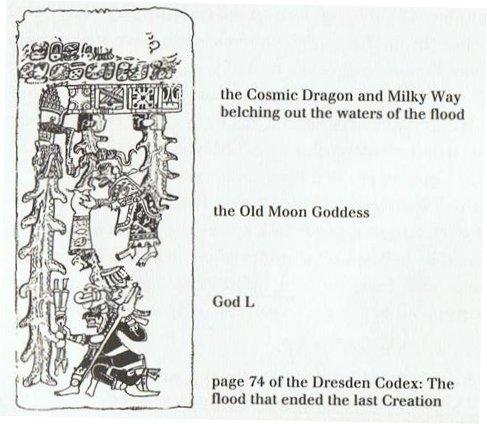Once again, 'the person worthy of respect' (tagata honui) resembles the Babylonian Great One who is standing on the Fish (Piscis Austrini) and this could explain te ika (not kahi) in Ca1-7: 
The position in the Babylonian zodiac was in winter. An inundated Field - comparable to how the Nile inundated its river banks before a new agricultural year could begin - was the result of water emanating from Aquarius and (according to Hevelius) from the Southern Fish. ... Now the deluge was caused by the male waters from the sky meeting the female waters which issued forth from the ground ... The Square of Pegasus became inundated, a Field beneath all the waters:
The Flood washing away the remains of the old year was evidently illustrated in Cb14-17 and we can compare with a Mayan version:
The watery delta of the Nile is a very fertile area and the star Delta (δ Andromedae) can be inserted in the Arabic structure precisely 8 days from the March equinox (if we should reduce its RA value with 0.4):
Fomalhaut (α Piscis Austrini) was used as a Sign by the Babylonians in winter (maybe 1 / 8 * 360 = 45 days from the solstice). In rongorongo times and for the March equinox Andromeda was the proper constellation. Fomalhaut would not be at spring equinox until far in the future, (365╝ - 347.4) * 71 = ca 1267 (= 7 * 181) years ahead. Instead of the upside down Southern Fish (maybe representing the 'dead old earth') the precession had pushed a pair of highly alive fishes (similar to the waxing and waning moons) to the position of the March equinox (where the old moon year could have been ending). Hevelius has put the nameless η Andromedae at the back side of the northern Fish in Pisces (a fish with open mouth, vaha mea):
Andromeda seems to represent Mother Earth returning to life again, because α Andromedae (Sirrah) at the back side of her head is a corner of the inundated Field. | ||||||||||||||||||||||||||||||||||||||||||||||||||||||||||||||||||||||||||||||||||||||||||||||||||||||||||||||||||







